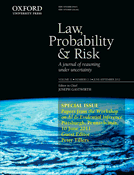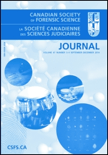
LAW PROBABILITY & RISK
Scope & Guideline
Bridging Law and Statistics for a Safer Tomorrow
Introduction
Aims and Scopes
- Statistical Evaluation of Evidence:
The journal emphasizes the use of statistical methods to assess various types of evidence in legal proceedings, including forensic evidence, eyewitness testimony, and expert opinions. - Bayesian Reasoning in Legal Contexts:
A core focus is on Bayesian approaches to legal reasoning, including the development and application of prior probabilities and likelihood ratios in assessing evidence. - Inconclusive Evidence and Error Rates:
There is a significant emphasis on the treatment of inconclusive evidence in forensic science and legal decision-making, exploring the implications of error rates and biases in interpretations. - Interdisciplinary Approaches:
The journal promotes interdisciplinary research that combines law, statistics, psychology, and forensic science, contributing to a more comprehensive understanding of legal processes. - Ethical Considerations in Evidence Evaluation:
Research often includes discussions on the ethical implications of statistical analyses in legal contexts, particularly concerning fairness and bias in judicial processes.
Trending and Emerging
- Machine Learning and Expert Evidence:
Recent publications are increasingly exploring the role of machine learning in evaluating expert evidence, highlighting the intersection of technology and law in evidence assessment. - Racial Profiling and Statistical Analysis:
There is a notable rise in research addressing racial profiling through statistical lenses, emphasizing the need for rigorous analysis in discussions about equity and justice in the legal system. - Complex Evidence Models:
The journal is seeing a trend towards the development of complex probabilistic models, such as probabilistic graphical models, to assess equivocal evidence, enhancing the sophistication of evidence evaluation. - Inconclusive Evidence Frameworks:
Emerging frameworks for understanding and interpreting inconclusive evidence are gaining traction, reflecting a broader recognition of the complexities associated with uncertainty in legal decision-making. - Interdisciplinary Collaborations:
An increasing number of studies are showcasing interdisciplinary collaborations, blending insights from law, statistics, psychology, and computer science to address contemporary legal challenges.
Declining or Waning
- Traditional Statistical Methods:
As the journal increasingly embraces Bayesian methods, traditional frequentist approaches may be receiving less attention, indicating a shift towards more modern statistical frameworks in legal analysis. - Generalized Forensic Applications:
Research purely focused on generalized applications of forensic statistics without a specific legal context appears to be waning, as the journal prioritizes studies that connect statistical findings directly to legal implications. - Single-Domain Studies:
There seems to be a decreasing trend in studies that focus solely on one domain of law or evidence type, as the journal moves towards more integrative approaches that consider multiple aspects of legal evidence.
Similar Journals

METHODOLOGY AND COMPUTING IN APPLIED PROBABILITY
Exploring the synergy between probability and computational techniques.METHODOLOGY AND COMPUTING IN APPLIED PROBABILITY is a distinguished journal published by SPRINGER, dedicated to advancing research in applied probability and its relationship with various computational methodologies. With an ISSN of 1387-5841 and an E-ISSN of 1573-7713, this journal provides a platform for innovative studies that bridge theory and practical application in the field of mathematics and statistics. Ranking in the Q2 category for Mathematics (miscellaneous) and Q3 for Statistics and Probability as of 2023, it reflects a robust academic discourse, featuring contributions that span a range of methodologies utilized in probability-related studies. The journal's sustained engagement in the academic landscape from 2004 to 2024 puts it at the forefront of ongoing developments in statistics and probability. Researchers, professionals, and students alike will find the insights found within to be invaluable for both theoretical understanding and practical implementation.

Doxa-Cuadernos de Filosofia y Derecho
Unlocking Ideas: Where Philosophy Meets Legal DiscourseDoxa-Cuadernos de Filosofia y Derecho, an esteemed journal published by Universidad de Alicante, serves as a vital platform for scholarly discourse in the fields of philosophy and law. Established with the intention of fostering an interdisciplinary understanding, the journal is indexed with an impressive Q1 ranking in Philosophy and a Q2 ranking in Law for 2023. With its Open Access policy implemented since 2016, Doxa ensures that cutting-edge research is freely accessible, promoting wider dissemination of ideas and encouraging academic collaboration. Housed in the picturesque city of Alicante, Spain, Doxa celebrates a converged publishing timeline from 2019 to 2023, reflecting its commitment to contemporary issues and dialogues within both disciplines. As a vital resource for researchers, professionals, and students, this journal invites contributions that push the boundaries of philosophical inquiry and legal scholarship.

Stats
Empowering researchers with open access to statistical innovation.Stats, published by MDPI, serves as an invaluable open access platform dedicated to the fields of statistics and probability. Since its inception in 2018, the journal has been committed to disseminating high-quality research and promoting innovation in statistical methodologies through a rigorous peer-review process. Operating from Basel, Switzerland, Stats offers a global reach and aims to foster collaboration among researchers, professionals, and graduate students alike. With an impact factor indicating its emerging significance, the journal resides in the Q4 quartile of the statistics and probability category for 2023 according to Scopus rankings. This positions it within the evolving landscape of statistical research, enhancing its visibility and accessibility. Researchers are encouraged to contribute to this dynamic field and benefit from the journal's dedication to open access publishing, ensuring that research findings can reach a broad audience without barriers.

Probability and Mathematical Statistics-Poland
Innovating Insights in Mathematical StatisticsProbability and Mathematical Statistics-Poland is a pivotal journal in the field of applied and theoretical statistics, published by WYDAWNICTWO UNIWERSYTETU WROCLAWSKIEGO. With an ISSN of 0208-4147, it serves as a platform for disseminating significant research grounded in mathematical statistics, probabilistic models, and their applications across various scientific disciplines. Although the journal resides in the Q4 category for Statistics and Probability, it plays an essential role for researchers seeking a peer-reviewed avenue for their work, particularly those affiliated with academic institutions in Poland and beyond. The journal has been in continuous publication from 2011 to 2023, reflecting its commitment to advancing knowledge in the field despite its current ranking at the 12th percentile in the Scopus listings. As an invaluable resource for researchers, professionals, and students alike, Probability and Mathematical Statistics-Poland encourages contributions that explore innovative statistical methodologies and their practical implications, fostering a deeper understanding of probability theory and its relevance in contemporary research.

REVSTAT-Statistical Journal
Connecting Ideas, Bridging Disciplines in Statistical Research.REVSTAT-Statistical Journal, published by the Instituto Nacional de Estatística (INE)Open Access model established in 2003, REVSTAT promotes the free dissemination of high-quality research, ensuring broad accessibility to its published works. Although it currently holds a Q4 category ranking in Statistics and Probability according to Scopus, the journal aims to enhance its contributions to the statistical community by featuring innovative methodologies, theoretical advancements, and applied statistical research. With a convergence period extending from 2010 to 2024, REVSTAT invites submissions that not only enrich the discipline but also encourage interdisciplinary collaboration. Its commitment to developing statistical knowledge makes it a noteworthy avenue for anyone seeking to engage with contemporary statistical discourse.

CRIMINAL LAW JOURNAL
Illuminating the path of criminal law practice.CRIMINAL LAW JOURNAL, published by LAWBOOK CO LTD, serves as a critical resource for legal practitioners, scholars, and students in the field of criminal law. With a dedicated focus on advancing the understanding of legal principles, case law, and statutory developments, this journal provides insightful articles, case analyses, and commentary from leading experts. Although it does not currently offer Open Access options, its rigorous peer-review process ensures the publication of high-quality research pertinent to contemporary issues in criminal law. The journal aims to foster academic discourse and promote best practices within the legal community. By maintaining a strong commitment to legal scholarship and education, the CRIMINAL LAW JOURNAL stands as a prominent platform for disseminating vital knowledge that influences policy-making and legal reform.

SOUTH AFRICAN STATISTICAL JOURNAL
Advancing statistical knowledge for a brighter future.SOUTH AFRICAN STATISTICAL JOURNAL, published by the SOUTH AFRICAN STATISTICAL ASSOCIATION, stands as a pivotal platform for advancing the field of statistics and probability, particularly within the South African context. Operating since 1996, this journal aims to bridge the gap between theoretical advancements and practical applications of statistical methodologies. Although currently categorized in the Q4 quartile in both Statistics and Probability, as well as Statistics, Probability and Uncertainty, it continues to serve as a crucial resource for researchers, practitioners, and students alike, encouraging the dissemination of research that tackles real-world statistical challenges. Despite not being an open access publication, the journal’s contributions are vital for anyone interested in the evolving landscape of statistical sciences, with each issue delving into diverse topics relevant to the field. With an ISSN of 0038-271X and an E-ISSN of 1996-8450, it invites the academic community to deepen their understanding and engagement with statistical practices through its thoughtfully curated content. The journal's emphasis on collaboration and knowledge-sharing is key in fostering innovation and enhancing statistical literacy within and beyond South Africa.

Canadian Society of Forensic Science Journal
Unveiling the Science Behind Forensic InvestigationsThe Canadian Society of Forensic Science Journal, published by Routledge Journals, Taylor & Francis Ltd, serves as a vital platform for the dissemination of research in the field of forensic science, particularly focusing on pathology and forensic medicine. With a rich history since 1968 and an impressive commitment to academic rigor, this journal has established itself as an essential resource for researchers, practitioners, and students alike. Recognized within the Q3 category in the 2023 Scimago Journal Rank in Pathology and Forensic Medicine, it ranks #162 out of 208 journals in its category, affirming its relevance and contribution to the field. While it does not operate under an open access model, the journal remains accessible through institutions and libraries and provides critical insights into advancements and best practices in forensic science. Through its comprehensive approach, the journal aims to advance forensic knowledge and contribute to the professional development of those engaged in this pivotal area of study.

ALEA-Latin American Journal of Probability and Mathematical Statistics
Elevating the discourse in probability and statistics.ALEA - Latin American Journal of Probability and Mathematical Statistics is a pivotal publication in the field of statistical theory and probabilistic modeling, published by the renowned Instituto de Matemática Pura e Aplicada (IMPA) in Brazil. Since its inception in 2011, this journal has steadily established itself as a key resource for researchers and academics, currently ranked in the Q2 category for Statistics and Probability as of 2023. With an H-index reflecting the sustained influence of its published research, ALEA serves not only as a platform for innovative studies but also as a vital conduit for the dissemination of cutting-edge statistical methodologies across the Latin American region and beyond. The journal is committed to maintaining high scholarly standards, encouraging open discussions on theoretical and applied aspects of probability and statistics. Access options include subscription-based access, ensuring a wide reach for its scholarly content. Whether you are a seasoned professional or a student embarking on your research journey, ALEA offers invaluable insights that contribute to the advancement of knowledge in the ever-evolving realm of mathematical statistics.

Pakistan Journal of Statistics and Operation Research
Exploring the Frontiers of Management ScienceThe Pakistan Journal of Statistics and Operation Research is an esteemed academic publication dedicated to the fields of statistics, operations research, and their applications. Published by University of Punjab, this journal features innovative research that contributes significantly to the advancement of knowledge in Management Science, Modeling and Simulation, and Statistics and Probability. With an impressive Scopus ranking and categorized in Q2 and Q3 quartiles, it actively disseminates high-quality findings in these critical areas of study, making it an essential resource for researchers, professionals, and students seeking to enhance their understanding and application of statistical methodologies and operational frameworks. Although it is primarily published in Pakistan, the journal’s influence is recognized internationally, encouraging a global perspective on complex statistical challenges. With its convergence years spanning from 2011 to 2024, readers can expect a continual flow of cutting-edge research and practical insights that address the evolving demands of the field.